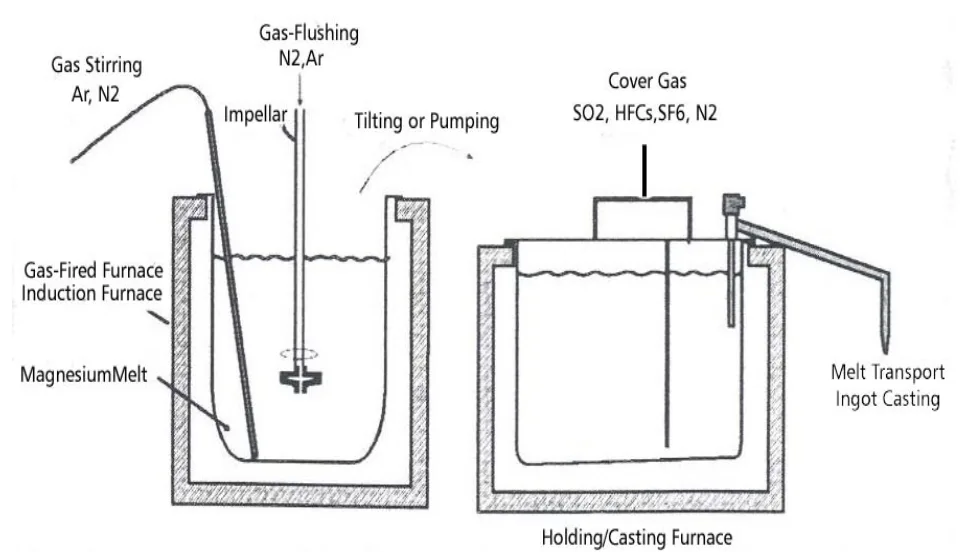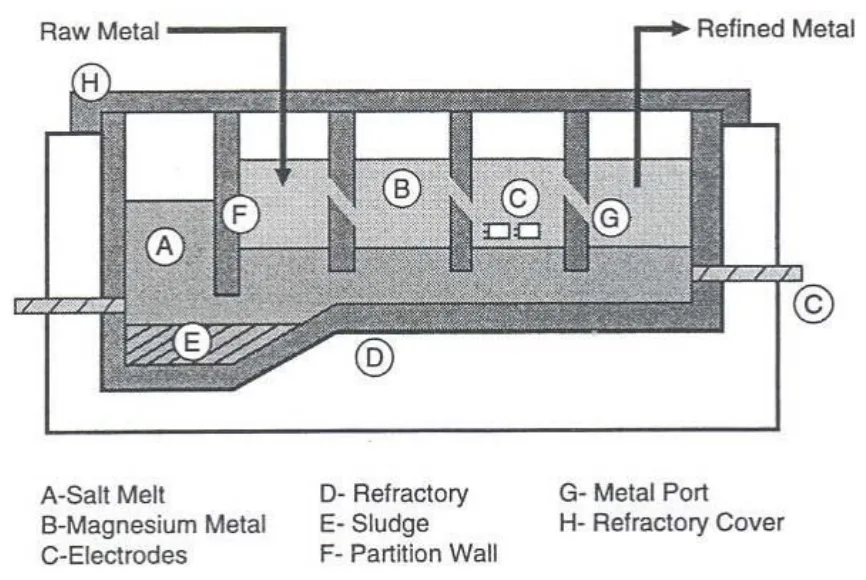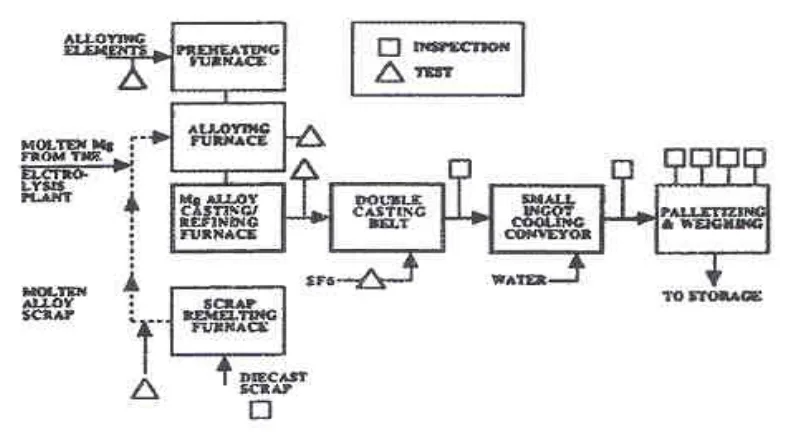This introductory paper is the research content of the paper "Final Report on Refining Technologies of Magnesium" published by Government of Canada.

1. Overview:
- Title: Final Report on Refining Technologies of Magnesium
- Author: S. Bell, B. Davis, A. Javaid and E. Essadiqi
- Publication Year: March 2006
- Publishing Journal/Academic Society: Government of Canada, Report No. 2003-19(CF)
- Keywords: Magnesium, Refining, Recycling, Flux, Fluxless, Distillation, Hydrometallurgy, Scrap, Environment.
2. Abstracts / Introduction
Magnesium recycling has become increasingly important due to the metal's growing use in automotive die-casting. To sustain this growth, all forms of die-cast magnesium scrap must be recycled. Currently, only high-grade (Class 1) scrap is routinely recycled, using either flux or fluxless methods. This is because existing refining technologies struggle to adequately clean the diverse types of scrap generated. This report aims to provide a comprehensive overview of current refining technologies at commercial, pilot plant, and research scales.
3. Research Background:
Background of the Research Topic:
The use of magnesium in the automotive industry has significantly increased. With approximately 50% yield in the die-casting, a large quantity of magnesium-based scrap had grown.
Status of Existing Research:
Existing research, as referenced in the 1999 International Magnesium Association (IMA) report, quantifies the types of scrap generated: 41% Class 1 scrap, 5% dross, 5% returns, and 36% gates, runners, and trim scrap¹. Most die-casting use Class 1 magnesium scrap.
Necessity of the Research:
Classes 2-8 magnesium scrap is not considered an economically viable option. These classes makes methods uneconomical. and causes the magnesium scrap to be either landfilled or stockpiled.
The increasing use of magnesium and accumulation of all scrap types is fueling a growing need for more effective magnesium refining systems.
4. Research Purpose and Research Questions:
Research Purpose:
To present current refining technologies used on a commercial, pilot plant, and research scale.
Key Research:
To provide a better understanding of the existing refining techniques, focusing on both flux-based and fluxless methods, as well as alternative approaches.
5. Research Methodology
Research Design:
This report is a literature review and analysis. No original experimental research design is presented.
Data Collection Method:
The data was collected from published reports, patents, and industry publications. Specific sources are listed in the References section.
Analysis Method:
The analysis is qualitative, involving a synthesis and categorization of different refining technologies based on their principles of operation, advantages, disadvantages, and applicability to different scrap classes.
Research Subjects and Scope:
The research encompasses a broad range of magnesium refining technologies, including:
- Flux Refining (composition, additives)
- Fluxless Refining (salt furnace, inert gas and filter, vacuum distillation)
- Other Methods (hydrometallurgy)
- Magnesium Scrap Classification (Appendix A)
- Pretreatment Requirements (Appendix B)
6. Main Research Results:
Key Research Results:
The report categorizes and describes the main refining technologies:
- Flux Refining: Utilizes molten salt fluxes to protect the magnesium from oxidation and to remove impurities. Key components of the flux are described (MgCl2, KCl, BaCl2, CaF2)³, along with the role of additives (MnCl2, B, Be) for removing specific metallic impurities. A typical flux refining process flow is shown in "Fig. 1 – Flux refining process."
- Fluxless Refining: Several techniques are discussed:
- Salt Furnace Technology: Developed by Norsk Hydro, this method uses particle sedimentation and adhesion in a multi-chamber furnace ( "Fig. 2 - Schematic picture of a four-chamber casting refining furnace"7.).
- Inert Gas and Filter Refining: Uses inert gas (typically argon) sparging and filtration to remove inclusions. The effectiveness of combining these methods is detailed, using Dow's process as an example ("Fig. 6 – DOW chemical plant for fluxless refining of magnesium die-casting scrap"15.).
- Vacuum Distillation Refining: Explores the potential of vacuum distillation for producing very high-purity magnesium (99.999%). A patented apparatus is described ("Fig. 8 - Patented vacuum distillation apparatus"16.).
- Hydrometallurgy: Briefly mentions a hydrometallurgical process for recycling slags and drosses.
Analysis of presented data:
- The amount of magnesium based scrap has grown.
- Natural Resources Canada estimated that, in 2000, 30% of all primary magnesium produced in the world was used in the die-casting industry.
- Flux Refining: It has been found that the best interaction between liquid flux and molten metal is achieved at 705°C³.
- Salt Furnace Technology: Norsk Hydro, is capable of producing 2-3 tons of refined magnesium per hours.
- Inert Gas and Filter Refining: The filter tested was a 410 stainless steel, cylindrical, Johnson wedge-screen with openings of 0.114 cm. It was determined that argon sparging alone, using the above sparger, produced a magnesium melt with an inclusion content of 100/cm². The resulting count of non-metallic inclusions 0.08 cm in size and greater was on average less than 0.05/cm².


Figure Name List:
- "Fig. 1 – Flux refining process."
- "Fig. 2 - Schematic picture of a four-chamber casting refining furnace"7.
- "Fig. 3 – Flowchart for Norsk Hydro Canada Inc.'s magnesium scrap recycling facility".
- "Fig. 4 – Vertical partitions for continual refinement of magnesium scrap"11.
- "Fig. 5 – Filter for removal on inclusions from molten magnesium scrap alloys"16.
- "Fig. 6 – DOW chemical plant for fluxless refining of magnesium die-casting scrap"15.
- "Fig. 7 - Rauch's in-house recycling furnace"15.
- "Fig. 8 - Patented vacuum distillation apparatus"16.
- "Fig. 9 - Innovative recycling path for future treatment of automotive magnesium scrap".
7. Conclusion:
Summary of Key Findings:
- Flux refining is effective for dirtier scrap but can introduce impurities and has environmental concerns.
- Fluxless refining offers higher purity potential but may be limited to cleaner scrap (Class 1) for some techniques.
- Vacuum distillation shows promise for very high purity but faces challenges in practicality and throughput.
- Hydrometallurgy is suitable for specific waste streams (slags, drosses) but may not be economical for all scrap types.
Academic Significance of the Study:
This report provides a valuable overview of the state-of-the-art in magnesium refining, consolidating information from various sources. It serves as a useful reference for researchers and industry professionals.
Practical Implications:
The report highlights the challenges and opportunities in magnesium recycling. It underscores the need for improved refining technologies to handle a wider range of scrap classes, particularly those beyond Class 1. This is crucial for the economic and environmental sustainability of magnesium use in the automotive industry.
Limitations of the Study and Areas for Future Research:
- The report is based on a literature review, and therefore, the findings are limited by the availability and scope of the reviewed publications.
- The report does not present original experimental data.
- Future research should focus on developing cost-effective and environmentally friendly refining methods for lower-grade magnesium scrap. This includes exploring advancements in fluxless techniques, optimizing vacuum distillation, and investigating novel approaches.
8. References:
- [1] R. Brown, “Magnesium Recycling Yesterday, Today, and Tomorrow”, The Minerals, Metals and Materials Society, (2000), pp. 1317-1329.
- [2] Natural Resources Canada, “Magnesium,” Canadian Minerals Yearbook, (1999), pp. 31.1-31.19.
- [3] H. Proffitt, “Magnesium and Magnesium Alloys”, Metals Handbook, 9, [2], (1989), pp. 801-802.
- [4] K. Bowman, “Magnesium by the Magnetherm Process – Process Contamination and Fused Salt Refining", Light Metals, (1986), pp. 1034.
- [5] G. Hanko, H. Antrekowitsch, and P. Ebner, “Recycling Automotive Magnesium Scrap”, Journal of Metals, 54, [2], (2002), pp. 51-54.
- [6] S. Housh and V. Petrovich, “Magnesium Refining: A Fluxless Alternative”, Society of Automotive Engineers, Paper No. 920071, (1992), pp. 2-5.
- [7] D. Oymo, et. al., “Particle Removal in Pure Magnesium, Light Metals, (1994), pp. 1017-1024.
- [8] L. Riopelle, “The Recycling of Magnesium Makes Cents”, Journal of Metals, October, (1996), pp. 44-46.
- [9] P. Pinfold and D. Oymo, “An Evaluation of Refined, Recycled AZ91D Alloy”, Society of Automotive Engineers, Paper No. 930420, (1993), pp. 65-66.
- [10] O. Wallevik and J. Ronhaug, “Method and Apparatus for Remelting and Refining Magnesium and Magnesium Alloys”, US patent, No. 5,167,700, (1992), pp. 1-7.
- [11] S. Kosarev, et al., “Electric Furnace and Method for the Continuous Refining of Magnesium", US Patent, No. 3, 882,261, (1975), pp. 1.
- [12] S. Cashion, N. Ricketts, and P. Hayes, “Cover Gas Protection for Magnesium”, Ph.D. Thesis, University of Queensland, (1997).
- [13] M. Walzak, et al., “Interfacial Reactions between SF6 and Molten Magnesium”, Magnesium 2001 TMS Annual Conference, (2001).
- [14] A. Ditze and C. Scharf, “Remelting of Magnesium Type 1 Scrap with or without Flux”, The Minerals and Materials Society, (2000), p. 1342.
- [15] Scharf and A. Ditze, “Present State of Recycling of Magnesium and its Alloys”, Magnesium Alloys and Their Applications, International Conference, (1998), pp. 685-690.
- [16] R. Lam and D. Marx, “Vacuum Distillation Apparatus for Producing Ultra High Purity Material", US patent, No. 5, 698, 158, (1997), pp. 1-12.
- [17] J. King, “Environmentally Acceptable Recycling In Europe”, Magnesium Elektron Company Report, (1995), p. 55.
- [18] "Recycling Process for Magnesium Alloy Scrap Metal”, Advance Alloys and Metals, 2, [6],(1990), pp. 14-15.
- [19] C. Brassard and L. Riopelle, “Recycling of Magnesium Scrap, A Necessity”, Light Metals: Proceedings of the Technical Sessions Presented by the TMS Aluminum Committee at the 126th TMS Annual Meeting, February, (1997), pp. 1111-1114.
9. Copyright:
- This material is S. Bell, B. Davis, A. Javaid and E. Essadiqi's paper: Based on "Final Report on Refining Technologies of Magnesium".
- Paper Source: https://www.researchgate.net/publication/242158707
This material was created to introduce the above paper, and unauthorized use for commercial purposes is prohibited.
Copyright © 2025 CASTMAN. All rights reserved.